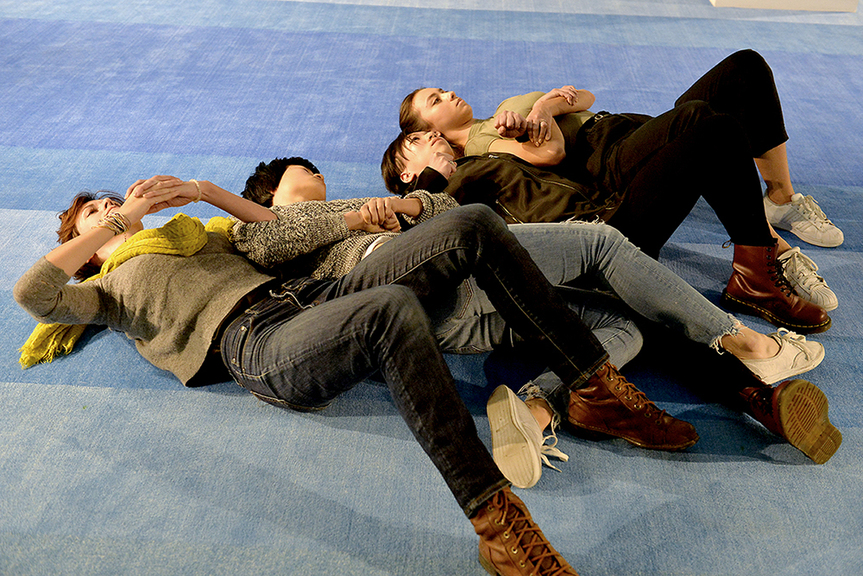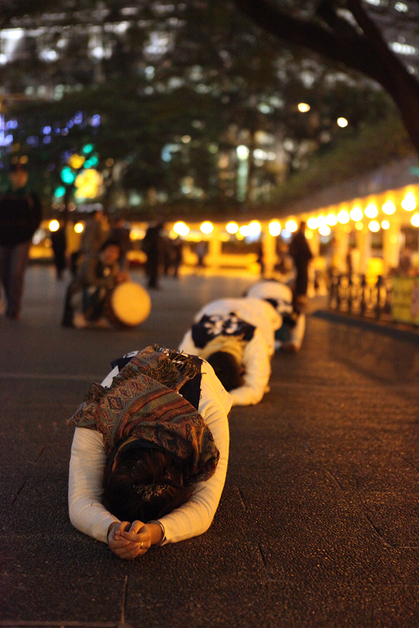
R
E
V N
E
X
T
Romanian performance artist Manuel Pelmuş’s solo exhibition, “Movements at an Exhibition,” recently transformed Hong Kong’s Para Site into a minimalist setting, marked only by concentric rectangular floor carpets that transition between hues of blue and green. The show consisted of four dancers performing a grand sequence looping between still, sculptural formations, silent movements, textual recitations, and choral singing. The polysemy of the word “movement” in the exhibition title—evoking physical motion, social movements, and structural units in a musical composition—set the tone for the ambitiously discipline-blurring project.
Segments of the exhibition were based on art-historical and socio-political events in Hong Kong and Taiwan over the last 50 years, such as the 1967 riots in Hong Kong, Taiwan’s Noise movement of the 1990s, and the recent Umbrella movement in Hong Kong in 2014. The Oslo-based artist, who had previously collaborated with Alexandra Pirici to choreograph the entire history of the Venice Biennale at the 55th edition of the festival, compiled information on these events during his residency at Para Site in the lead-up to the show.
Pelmuş recently sat down with ArtAsiaPacific to discuss the historical tension of performative actions in an object-based visual art world, and his strategy of reproducing and translating these differences back to the body.
What was the role of the archive in this exhibition? How did you choose materials from the archive?
For research, I spent a lot of time at Asia Art Archive, as well as at their Ha Bik Chuen archive. I also visited Taiwan, where I went to an exhibition and sound archive, “Altering Nativism – Sound Cultures in Post-War Taiwan,” curated by Amy Cheng, Jeph Lo, and Tung-hong Ho. It strikes me that some of these moments, like the “Out of Context” art show in 1988, were largely unknown even within the art circle. So, there is a pedagogical function to inform the public and to bring these events out of the archive.
However, this exhibition is not an art-historical research project. I was looking through the archives because one of the main characteristics of performance is that it is done only once, and continues to be circulated as documentation, like photographs, recording footage and written documents. Its existence within the logic of the visual arts is object-oriented. So, the archive for me is a trigger and an entry point, to see what would happen if we bring these action-events back to the body.
In the exhibition text, I quoted Dorothea von Hantelmann, who writes that the specificity of performance is time, and that it “makes us aware that meaning takes place in the present.” For me to re-present them in a different context, in the present and in the white cube, is an act of translation without equivalence.
Your emphasis on translation is important here. Translation involves the re-telling of specific materials in a new language and medium. What is your strategy in its performative turn? Are values like fidelity, authenticity and originality important in your translation?
Of course, I look at the original and I try to respect it. These events enter into my exhibition as quotations: the names of the artist, work titles, and contexts of the performance are clearly stated. In that regard, I am conscious of being an outsider appropriating something, without claiming it as mine.
My strategy is to reproduce it by multiplying it. Always with performance art, an action is performed once by a performer, and then passed on from one body to another. Like a score, you start seeing differences in different performer’s interpretation, which is very unlike the fixity of object- or image-based work. I’m interested in the subjective take on translation, so there is no pretense that they are the same. This attempt is quite honest in articulating something central to the action, and it stays true with the intention.
Beyond the valences of bodies or voices joining in solidarity and unison in street movements, repetition is important in its formal subversion. Visual art is very insistent on the one, the signature, and the unique, whereas in dance or theatre, repetition is the modality of conservation. This repetition always presupposes that you pass on the choreography, the gesture, in order to not only to last through time, but also simply to show it again. This is fundamentally resistant to the valuing system of visual art, which always tries to appropriate performance as a commodity of an object.
Why did you only focus on Hong Kong and Taiwan for this show? Was there a political agenda?
Originally, the scope was Southeast Asia and China. But when I arrived [in Hong Kong], I found the scope too broad, and I wouldn’t be able to comprehend it. After all, this exhibition is not meant to be an exhaustive study of the history of performance art in the region.
Of course, there was one common thread between the island regions of Hong Kong and Taiwan. All the artists I talked to mentioned the strained and strange relationship to the behemoth of the PRC. Of course, this is not the subject of most of the performative actions quoted in my exhibition, as they were directed toward other political and capitalist establishments at the time, like the KMT military, British colonial government or Capitalism in capital letters. But the specter simply cannot be ignored, and lingers in the background. Coming from the eastern bloc in Europe, I felt an analogous relationship with our regard of Russia.
You decided to have the songs sung in the original Hokkien-Taiwanese, which is alien and incomprehensible to the predominantly Cantonese audience. With a mostly local crew of performers, why not present Cantonese songs, such as the ones sung during the Umbrella movement, for example?
That’s why we opted to have the text of the lyrics printed. It didn’t matter to me that the performers are not native speakers of Hokkien-Taiwanese and it’s not perfectly sung. It’s fair enough to try to keep the song in its original language, even if we fail, rather than translating it to English.
I insist on using the original songs in the Taiwanese context because the use of sound was a distinct characteristic of the post-war Taiwanese avant-garde art scene, in connection with the student movements. The preeminence of sound popped up everywhere in my research and interviews with artists and scholars.
In addition, these Taiwanese songs have been circulated and mediated by the visual art system. It’s been already archived, and presented as an art object, listened to through headphones installed in an art space. So it is important for me to bring them back to the body. This is unlike, for example, songs sung in protests in Hong Kong, which remain too open for me. Anyhow, movements in Hong Kong remain fascinating to me in the conjoining arrangements of bodies, which inform most of the silent formations in the exhibition.
MANUEL PELMUŞ’s performance at the opening reception of “Movements at an Exhibition” at Para Site, Hong Kong, 2017. Photo by Eddie CY Lam. Courtesy Image Art Studio.
Your use of sound and silence reminds me of a phrase you uttered in an earlier lecture-performance at Para Site: “A temporary suspension of the hegemony of the visual, and of the distancing it affirms and sustains.” What are your thoughts on distance in your practice?
The sense of distancing in the exhibition space is quite a modernist construct. A gesture from 1967 embodies a historical distance. There’s an intensity so powerful, in the way that there is another body enacting it in close proximity to you in the same room. In my choreography, I insist a lot on the formation, not so much on the acting, and my dancers are instructed to be neutral and not be in performance mode. For example, when evoking the formation of a line in front of riot police, they don’t act it out, but simply arrange themselves accordingly. This line evokes a very strong position, because it comes from the streets—it means something even if it is taken out of context. It is uncanny, it informs the space.
“Movements at an Exhibition” is on view at Para Site until February 18, 2018.
To read more of ArtAsiaPacific’s articles, visit our Digital Library.






